For the 2025 school year, there are 2 public middle schools serving 322 students in Whitney Independent School District. This district's average middle testing ranking is 5/10, which is in the bottom 50% of public middle schools in Texas.
Public Middle Schools in Whitney Independent School District have an average math proficiency score of 41% (versus the Texas public middle school average of 40%), and reading proficiency score of 44% (versus the 52% statewide average).
Minority enrollment is 33% of the student body (majority Hispanic), which is less than the Texas public middle school average of 75% (majority Hispanic).
Overview
This School District
This State (TX)
# Schools
5 Schools
2,747 Schools
# Students
1,475 Students
1,489,538 Students
# Teachers
116 Teachers
103,135 Teachers
Student : Teacher Ratio
13:1
13:1
District Rank
Whitney Independent School District, which is ranked #641 of all 1,196 school districts in Texas (based off of combined math and reading proficiency testing data) for the 2021-2022 school year.
The school district's graduation rate of 90-94% has stayed relatively flat over five school years.
Overall District Rank
#629 out of 1204 school districts
(Bottom 50%)
(Bottom 50%)
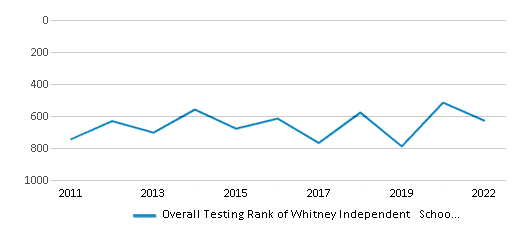
Math Test Scores (% Proficient)
41%
41%
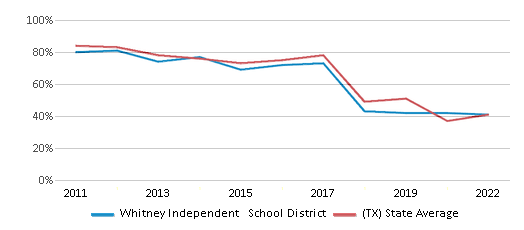
Reading/Language Arts Test Scores (% Proficient)
47%
51%
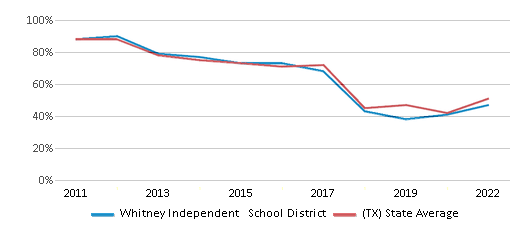
Science Test Scores (% Proficient)
45%
46%
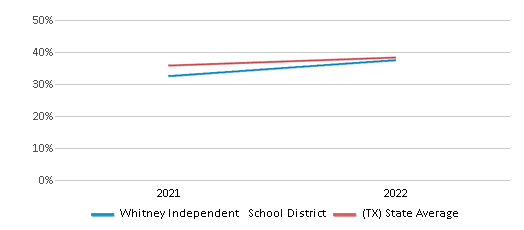
Graduation Rate
90-94%
90%
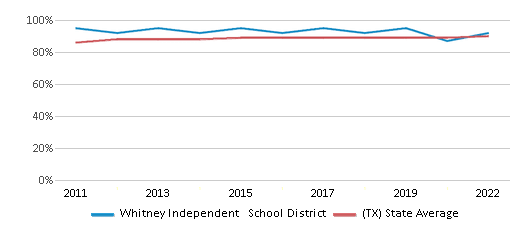
Students by Ethnicity:
Diversity Score
0.49
0.64
# American Indian Students
3 Students
5,199 Students
% American Indian Students
n/a
n/a
# Asian Students
3 Students
77,599 Students
% Asian Students
n/a
5%
# Hispanic Students
369 Students
795,444 Students
% Hispanic Students
25%
53%
# Black Students
51 Students
186,072 Students
% Black Students
4%
13%
# White Students
984 Students
378,957 Students
% White Students
67%
26%
# Hawaiian Students
1 Student
2,404 Students
% Hawaiian Students
n/a
n/a
# Two or more races Students
64 Students
43,863 Students
% of Two or more races Students
4%
3%
Students by Grade:
# Students in PK Grade:
90
15,212
# Students in K Grade:
97
21,462
# Students in 1st Grade:
101
22,752
# Students in 2nd Grade:
92
22,958
# Students in 3rd Grade:
98
22,862
# Students in 4th Grade:
118
22,563
# Students in 5th Grade:
108
30,190
# Students in 6th Grade:
111
326,610
# Students in 7th Grade:
102
406,424
# Students in 8th Grade:
109
414,179
# Students in 9th Grade:
137
56,165
# Students in 10th Grade:
103
48,628
# Students in 11th Grade:
109
42,213
# Students in 12th Grade:
100
37,320
# Ungraded Students:
-
-
District Revenue and Spending
The revenue/student of $14,506 is higher than the state median of $13,387. The school district revenue/student has stayed relatively flat over four school years.
The school district's spending/student of $12,637 is less than the state median of $14,116. The school district spending/student has stayed relatively flat over four school years.
Total Revenue
$21 MM
$74,029 MM
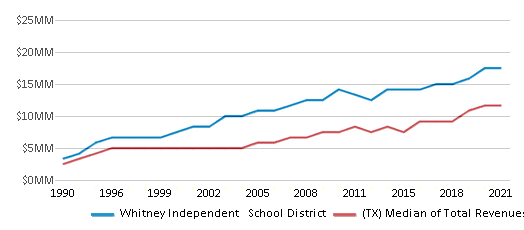
Spending
$19 MM
$78,063 MM

Revenue / Student
$14,506
$13,387
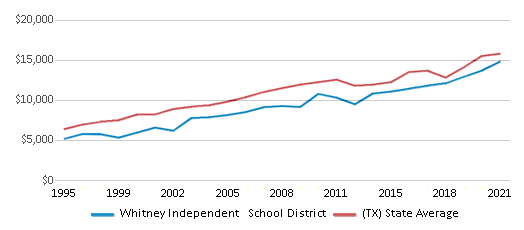
Spending / Student
$12,637
$14,116
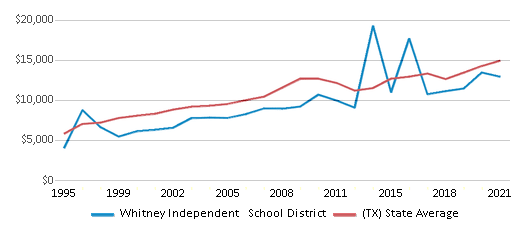
Best Whitney Independent School District Public Middle Schools (2025)
School
(Math and Reading Proficiency)
(Math and Reading Proficiency)
Location
Grades
Students
Rank: #11.
Whitney Middle School
(Math: 41% | Reading: 44%)
Rank:
Rank:
5/
Bottom 50%10
185 Hcr 1240
Whitney, TX 76692
(254) 694-6768
Whitney, TX 76692
(254) 694-6768
Grades: 6-8
| 322 students
Rank: n/an/a
Whitney Alternative Education Center
Alternative School
1501 N Brazos St
Whitney, TX 76692
(254) 694-8379
Whitney, TX 76692
(254) 694-8379
Grades: 2-12
| n/a students
Recent Articles

What Is A Charter School?
Explore the world of charter schools in this comprehensive guide. Learn about their history, how they operate, and the pros and cons of this educational innovation. Discover key facts about charter schools, including admission policies, demographics, and funding, as well as what to look for when considering a charter school for your child.

10 Reasons Why High School Sports Benefit Students
Discover the 10 compelling reasons why high school sports are beneficial for students. This comprehensive article explores how athletics enhance academic performance, foster personal growth, and develop crucial life skills. From improved fitness and time management to leadership development and community representation, learn why participating in high school sports can be a game-changer for students' overall success and well-being.

February 05, 2025
Understanding the U.S. Department of Education: Structure, Impact, and EvolutionWe explore how the Department of Education shapes American education, from its cabinet-level leadership to its impact on millions of students, written for general audiences seeking clarity on this vital institution.





